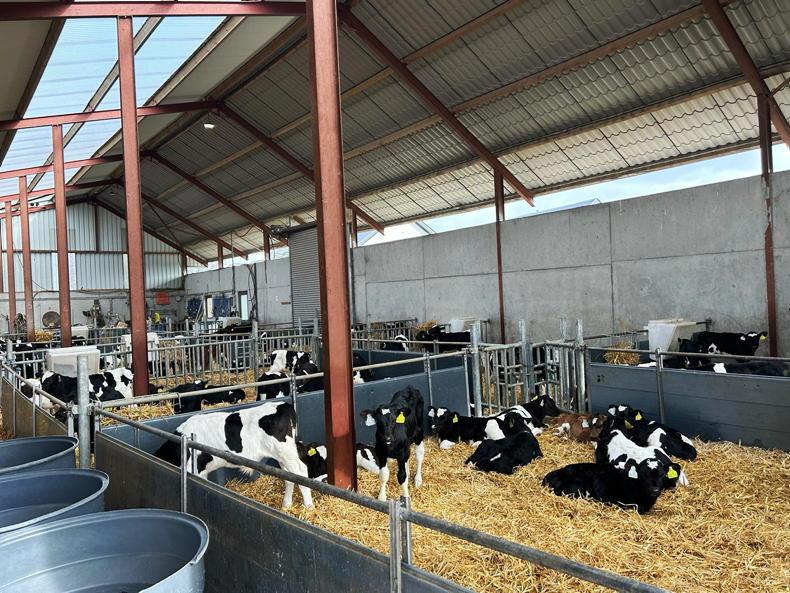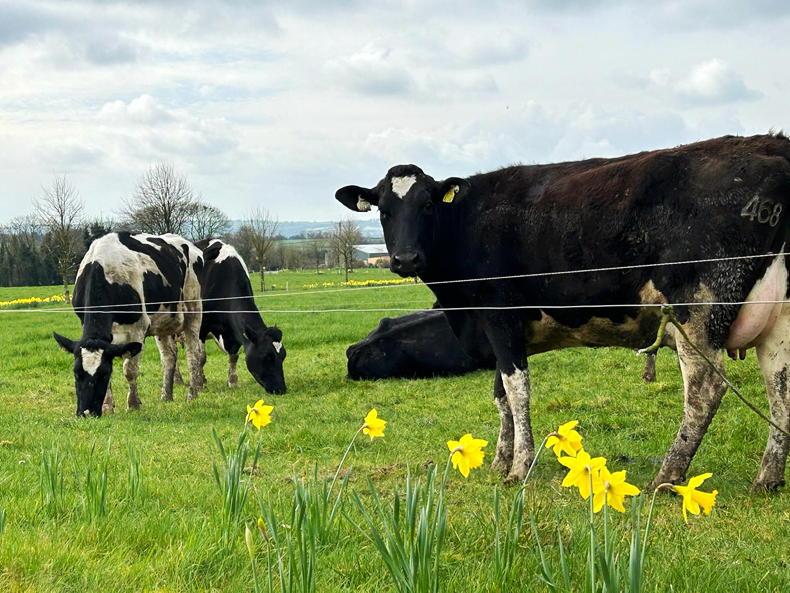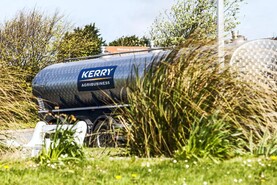Spring is running smoothly on the Troy family farm in north Cork, with 85% of the herd calved down and 47% of the milking platform grazed.
Robert and Mary Troy are milking about 450 cows on a 130ha milking platform in Newtownshandrum, Co Cork.
The farm is stocked at 3.3 cows per hectare on the milking platform and 2.5 cows per hectare overall.
There is another 80ha support block two miles away, where calves and heifers are reared and silage is cut. Most of the cows are wintered there also.
With nearly half of the milking platform grazed to date, the Troys are getting cows out to grass twice a day with minimal damage. Cows are milked in the morning at 6.30am and again at 3pm in the afternoon.
“We wait until 8.30am to leave out the cows together this spring, as they are going out to graze and back in.
"If we left out the cows as they were milked, the first of the cows would have dirtied the grass and wasted some of it by the time the last cow reaches the field,” says Robert.
Batt latch
He is using a batt latch, which is set to open the gap for cows. For the past week, when cows are out after the evening milking, the batt latch is set for 8.30pm and cows can choose to go in or stay out. The batt latch is saving 40 minutes in a 2km walk in the main grazing season.
Cows are currently on a diet of 4kg of meal with a couple of grabs of silage put in front of cows for the night and the rest is grass.
Robert said that getting cows out to grass early is worth 0.2% in protein compared with feeding silage where cows are now producing 3.45% protein and 4.85% fat.
By having a high protein percentage in early lactation, it generally holds for the year if grass is well managed.
On the outside block, bulling heifers and dry cows have been turned out to grass.
Robert says there is plenty of grass there, with silage stocks tight and the cost of feeding it out, he’s happy to get them out while he can.
Calving

Robert and Mary Troy have 85% of the herd calved in six weeks.
Calving has gone well so far with little to no issues. Robert says doing the simple things right, keeping fresh dry beds and colostrum as soon as possible gives calves a great chance. Calves are all in group pens and fed with teat feeders.
To date, 40% of the farm has been covered with 2,500 gallons of slurry per acre and the rest of the farm has got 23 units of urea.
Robert says he plans to spread more slurry and fertiliser soon on grazed ground. The target is to have 60 units of nitrogen per acre on the whole farm by the beginning of April.
With the farm growing over 14t DM/ha annually, Robert front-loads nitrogen application in the spring to get the best return per unit spread, as response is higher and clover content is lower.
Clover tends to take off from July on and the reins are then pulled on the fertiliser spreader.
The Troys’ holding is a fifth-generation family farm, with two full-time staff in addition to the family labour.
Most of the machinery work is contracted out, including slurry, silage and fertiliser.
This year, Robert has a worker coming in to put in silage three days a week from 6.30am to 9am.
Herd profile

Robert Troy's farm in Cork.
The herd consists of Holstein-Friesian cows. Twenty years ago, Robert bred first-cross Jersey, but now he believes the
Holstein genetics can compete with the fertility and solids of the Jersey cow. Cows produced 450kg MS per cow in 2023 from 800kg of meal per cow.
Somatic cell count on the farm is between 80,000 and 85,000 this spring.
Mary has been using selective dry cow therapy for the past few years. She set the bar for cows under 70,000 SCC consistently for the whole year to get selective dry cow therapy.
In 2022, 45% of the herd didn’t get any antibiotics, but that reduced to 35% in 2023 as the year was wet.
The Troys are part of the Kerry Evolve Programme, where farmers are rewarded financially for practicing sustainable farming.
Farm visit
Fifth and sixth year agricultural science students from Charleville CBS were recently shown around the farm by the Troys and Kerry milk quality adviser Darragh O’Connor.
The Troy farm was used as an example of what a sustainable dairy farm looks like in Ireland. It’s a low-cost system, where everything revolves around a spring-calving pattern to maximise grass utilisation and minimise imported feed.
Spring is running smoothly on the Troy family farm in north Cork, with 85% of the herd calved down and 47% of the milking platform grazed.
Robert and Mary Troy are milking about 450 cows on a 130ha milking platform in Newtownshandrum, Co Cork.
The farm is stocked at 3.3 cows per hectare on the milking platform and 2.5 cows per hectare overall.
There is another 80ha support block two miles away, where calves and heifers are reared and silage is cut. Most of the cows are wintered there also.
With nearly half of the milking platform grazed to date, the Troys are getting cows out to grass twice a day with minimal damage. Cows are milked in the morning at 6.30am and again at 3pm in the afternoon.
“We wait until 8.30am to leave out the cows together this spring, as they are going out to graze and back in.
"If we left out the cows as they were milked, the first of the cows would have dirtied the grass and wasted some of it by the time the last cow reaches the field,” says Robert.
Batt latch
He is using a batt latch, which is set to open the gap for cows. For the past week, when cows are out after the evening milking, the batt latch is set for 8.30pm and cows can choose to go in or stay out. The batt latch is saving 40 minutes in a 2km walk in the main grazing season.
Cows are currently on a diet of 4kg of meal with a couple of grabs of silage put in front of cows for the night and the rest is grass.
Robert said that getting cows out to grass early is worth 0.2% in protein compared with feeding silage where cows are now producing 3.45% protein and 4.85% fat.
By having a high protein percentage in early lactation, it generally holds for the year if grass is well managed.
On the outside block, bulling heifers and dry cows have been turned out to grass.
Robert says there is plenty of grass there, with silage stocks tight and the cost of feeding it out, he’s happy to get them out while he can.
Calving

Robert and Mary Troy have 85% of the herd calved in six weeks.
Calving has gone well so far with little to no issues. Robert says doing the simple things right, keeping fresh dry beds and colostrum as soon as possible gives calves a great chance. Calves are all in group pens and fed with teat feeders.
To date, 40% of the farm has been covered with 2,500 gallons of slurry per acre and the rest of the farm has got 23 units of urea.
Robert says he plans to spread more slurry and fertiliser soon on grazed ground. The target is to have 60 units of nitrogen per acre on the whole farm by the beginning of April.
With the farm growing over 14t DM/ha annually, Robert front-loads nitrogen application in the spring to get the best return per unit spread, as response is higher and clover content is lower.
Clover tends to take off from July on and the reins are then pulled on the fertiliser spreader.
The Troys’ holding is a fifth-generation family farm, with two full-time staff in addition to the family labour.
Most of the machinery work is contracted out, including slurry, silage and fertiliser.
This year, Robert has a worker coming in to put in silage three days a week from 6.30am to 9am.
Herd profile

Robert Troy's farm in Cork.
The herd consists of Holstein-Friesian cows. Twenty years ago, Robert bred first-cross Jersey, but now he believes the
Holstein genetics can compete with the fertility and solids of the Jersey cow. Cows produced 450kg MS per cow in 2023 from 800kg of meal per cow.
Somatic cell count on the farm is between 80,000 and 85,000 this spring.
Mary has been using selective dry cow therapy for the past few years. She set the bar for cows under 70,000 SCC consistently for the whole year to get selective dry cow therapy.
In 2022, 45% of the herd didn’t get any antibiotics, but that reduced to 35% in 2023 as the year was wet.
The Troys are part of the Kerry Evolve Programme, where farmers are rewarded financially for practicing sustainable farming.
Farm visit
Fifth and sixth year agricultural science students from Charleville CBS were recently shown around the farm by the Troys and Kerry milk quality adviser Darragh O’Connor.
The Troy farm was used as an example of what a sustainable dairy farm looks like in Ireland. It’s a low-cost system, where everything revolves around a spring-calving pattern to maximise grass utilisation and minimise imported feed.








 This is a subscriber-only article
This is a subscriber-only article





